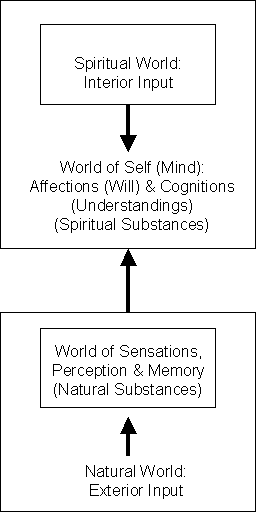Swedenborg's Science of Correspondences:
An Empirical Method for the Psychology of Religion
Leon James
© 1987
OUTLINE
I. Psychology of Religion: Strong
and Weak Versions
1. Weak Version: - religious
issues
- Studied through monism & Null Hypothesis (cannot think/feel about
other world)
2. Strong Version: -psychological
study of dualistic phenomena
- (Transcendental) (Trans-personal) (positive bias about other world)
II. Swedenborg?s Religious Behaviorism
A) Spiritual = affections + cognitions
=
interior input (inner life)
Natural
= sensory exterior input
Figure 1 ? Swendenborg?s description of
the person as a dual being

B) Separate,
but corresponding relation between spiritual and natural parts of
a person.
i) General version:
- moral deterioration of man leads to natural
calamities (social breakdown and disease and
ugliness).
ii) Specific version:
- religious feelings and thoughts (i.e. about dualistic ideas)
- (interior input)
- externalize as natural
- corresponds ("symbolism")
- corresponds ("parables")
- (i.e. natural ideas without negative bias)
VS.
| Philosophical |
Communal |
| Speculative |
Collective |
| Subjective |
Objective |
| Idiosyncratic |
Phenomenal |
| Non-empirical |
Empirical |
| Fantastic |
Actual |
| Cultist |
Experiential |
|
Observational |
III. Science of Correspondences:
A)
General Version:
|
SPIRITUAL |
SPIRITUAL |
NATURAL |
|
Affections |
Cognitions |
Sensations/Memories |
| i) |
Love
of Self |
ideas
that justify
DOMINION OVER OTHERS |
attachments
& focus on
PHYSICAL PLEASURES & GAIN |
| ii) |
Love
of the world |
ideas
that justify
EQUITY MORALITY |
attachments
& focus on
NORMS & MERIT |
| iii) |
Love
of others |
ideas
that justify
FAITH OBEDIENCE |
attachments
& focus on
RITUALS & CREED |
| iv) |
Love
of God |
ideas/doctrines
that justify
ALTRUISM |
attachments
& focus on
GOOD WORKS |
B)
Specific Version:
| 1. |
LOVE |
WISDOM |
USES |
| 2. |
GOOD |
TRUTH |
POWER |
| 3. |
ESSENCE
(ESSE) |
CAUSE |
EFFECT |
| 4. |
FIRST END
(GOAL) |
MEDIATE END
(INSTRUMENTALITY) |
ULTIMATE END
(PRODUCT) |
| 5. |
WILL
(AFFECTIVE |
UNDERSTANDING
(COGNITIVE) |
ULTIMATE END
(PRODUCT) |
| 6. |
INTENTION |
PLAN |
EXECUTION |
IV. Applications: Applied Theistic
Psychology (spiritual geography)
A)
Communal (collective) revelations
(spiritual communications) (e.g. Bible)
(prophetical) (visions) (Divine)
(commandments) (guides)
B)
Dreams
(see Journal of Dreams)
(self-revelation) (growth) (preparation)
C)
Metaphor in everyday expressions
(trigrammatic theories) (critical thinking ability)
D)
Instructional Parables
(spiritual attitudes) (proper strivings)
(reformation) (repentance)
E)
Illustration (insight) (moral wisdom)
(regeneration) (mental health) (self exam)
etc.)
indicates sub-areas of study (THEORY & RESEARCH) for Theistic Psychology.
Research issues:
A1) What is the
difference between guides to conduct from a religious source (collective
revelation) and non-religious source (human invention)?
|
IV
1
|
IV
2
|
|
Revealed Scriptures
|
Human Invention
|
DV1
- mental health (Tillich)
DV2 - productivity
etc. - lifestyle |
|
B1) What are
valid methods of dream analysis?
C1) Does thinking
improve with the study of semantic relations based on correspondences?
D1) How hoes an
acquired transpersonal orientation (or practice of religion) bring about
personal change
and adjustment?
E1) How is goodness
attained?
| 
